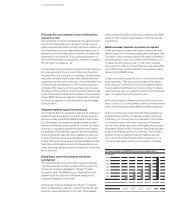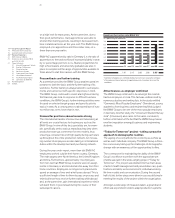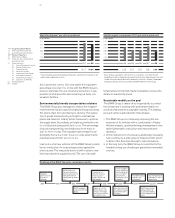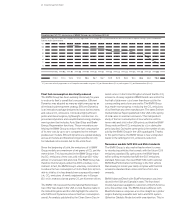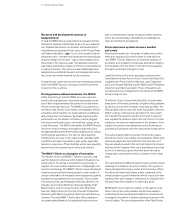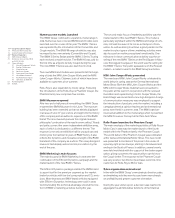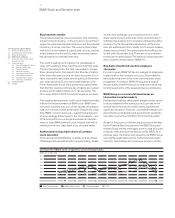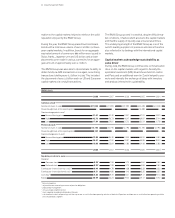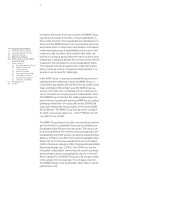BMW 2008 Annual Report Download - page 36
Download and view the complete annual report
Please find page 36 of the 2008 BMW annual report below. You can navigate through the pages in the report by either clicking on the pages listed below, or by using the keyword search tool below to find specific information within the annual report.
37 Group Management Report
Research and development expense at
budgeted level
In the BMW Group scaled down its research and de-
velopment expense intentionally by . to euro , mil-
lion. Detailed disclosures on research and development
expenditures are provided in the notes to the Group Finan-
cial Statements (Note ). At . , the research and de-
velopment ratio – research and development expenditures
as a percentage of revenues – was . percentage points
lower than in the previous year. This targeted reduction
was mainly achieved by means of efficiency improvements
to work processes. The rigorous value-added approach
adopted ensures that all research and development activi-
ties create discernible benefits for the customer.
During the year under report, some , employees worked
within the BMW Group’s innovation network at eleven
locations in five countries.
Driving pleasure without emissions: the MINI E
At the beginning of the BMW Group became the
world’s first manufacturer of premium automobiles to de-
ploy a fleet of approximately purely electrically driven
vehicles for private daily use. The MINI E is powered by a
kW ( hp) electric motor fed by a rechargeable lithium-
ion
battery which transfers its power almost soundlessly
and entirely free of emissions. Specially engineered for
automobile use, the lithium-ion battery can be plugged
into any conventional power outlet and has a range of up
to kilometres. The MINI E exemplifies the BMW Group’s
resolve to reduce energy consumption and emissions
through targeted development and by drawing on its unique
technological expertise in the field of drive systems.
Putting some cars on the road under real daily traffic
conditions will make it possible to gain widely applicable
hands-on experience. These findings will be subsequently
factored into the engineering of series-built vehicles.
The BMW 7 Series as champion of innovation
The launch of the new BMW 7 Series in autumn
saw the debut of numerous technological innovations in a
series vehicle. As well as a completely revised range of
engines, the new models make full use of lightweight con-
struction technology. The BMW 7 Series’ newly developed
chassis ensures optimal driving dynamics and comfort. A
unique combination of innovative driver assistance systems
has been incorporated in the new models. This includes
functions such as Lane Departure Warning, Speed Limit
Display, Lane Change Warning, Head-up-Display, High
Beam Assist, Active Cruise Control with Stop & Go
function, Night Vision (for the first time with Pedestrian
Detection
and Warning system), Side View and Back-up
Camera.
The new BMW 7 Series also offers maximum
occupant safety thanks to its optimised body structure
and a comprehensive range of passive safety systems
which are electronically controlled and coordinated to
react as intended in all situations.
Driver assistance systems increase comfort
and safety
Numerous innovations in the areas of safety and comfort
were also introduced for the first time in with the
new BMW 7 Series. Based on an extensive analysis of
accidents, an integrated concept was developed, ranging
from assistance for the driver in normal driving situations
through to automatic emergency calls.
Useful functions of the driver assistance systems men-
tioned above include Active Cruise Control with Stop & Go
capability and Front Collision Warning, Lane Departure
and
Lane Change Warning and the Night Vision Pedestrian
Detection and Warning system. These innovations are
successively being integrated into the whole of the BMW
Group’s range of cars.
The Active Cruise Control with Stop & Go function takes
away some of the tasks generally considered less pleasant
by drivers such as when driving in stop and go traffic. Ad-
ditional radar sensors warn the driver of possible collisions.
Within a range of between and km / h, the system
will maintain the speed set by the driver and, if required,
also regulate the distance kept to the car in front. In critical
situations, the driver is made aware of the situation. If the
situation becomes more dangerous an acute warning is
activated, still giving the driver the opportunity to take action.
The Lane Change Warning system monitors the space
behind the vehicle over a range of several lanes. When other
road users approach from behind in the next lane or if
they are already located in the car’s blind spot, the driver is
informed of the situation if the car is travelling at more than
km / h. A warning is given when the driver intends to
change lanes and another vehicle is located in the critical
area.
The Lane Departure Warning system keeps a check on lane
markings for a distance of up to metres. The system is
mainly designed for primary routes and motorways. When
the driver unintentionally leaves a lane, a warning of the
critical situation is given before the vehicle crosses the lane
marking. If the lane change is intentional, for example if the
indicator has been activated, no warning is given.
BMW Night Vision improves visibility in the dark for a dis-
tance of up to metres ahead. Any thermal radiation
emitted by the surroundings and objects is converted into
an image by the vehicle’s infrared camera and shown in the
control display. The second generation of the Night Vision


